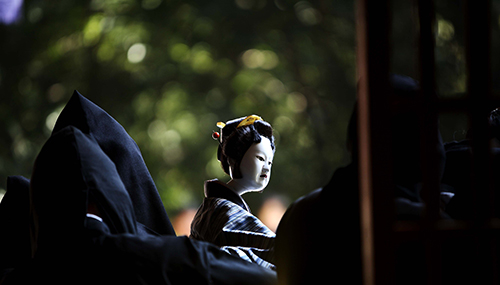文字サイズ
Tokushima Prefecture
Ningyo Joruri is a puppet show created by the fusion of Dayu (a story teller using Gidayu-bushi, ballad drama music), Shamisen (three-stringed instrument) and Sannin-zukai (three puppeteers for each puppet). Characteristics of Tokushima’s Ningyo Joruri are its unique performance and larger-sized puppet heads for outdoor theaters built in the precincts of temples (Rural Community Theaters). “Awa Ningyo Joruri” has been designated as National Important Tangible Folk Cultural Property.
Tokushima Prefecture endeavors to pass on through the generations and develop “Awa Ningyo Joruri”. The puppet shows are performed in Awa Jurobe Yashiki and Rural Community Theaters in various areas in Tokushima Prefecture.

Awa Ningyo Joruri puppet shows are performed every day in Awa Jorobe Yahiki.
You can thoroughly enjoy Japanese sensitive art: Dayu tells a story with a full range of emotions; Gidayu-Shamisen supports the story teller with a variety of timbre beyond musical notation; and each Ningyo (puppet) is manipulated by three puppeteers, which is absolutely unique.
Mainly “Keisei Awa no Naruto” is performed there, which is associated with Tokushima. The performance is a story based on a family trouble and uses the name of a village headman, Bando Jurobe, who was executed in 1698 without an obvious criminal charge and became a victim of the Han’s (feudal domain) politics. The theater is located in the former residence of Bando Jurobe, a place associated with “Keisei Awa no Naruto”.

Eighty-eight Rural Community Theaters, built between Edo Period and Taisho Period (1603–1925) for puppet plays, still remain mainly in the south of Tokushima Prefecture. The number of Rural Community Theaters is the highest in Japan. The theaters are irreplaceable places built by the local residents cooperating with each other and where they enjoyed their precious time together, being surrounded by beautiful nature with greenery, the sound of streams and sacred air coming through the precincts. Performances including Ningyo Joruri are shown at approximately ten Rural Community Theaters every year.

Ningyo Joruri was performed by the Ningyoza (touring troupe) from Awaji and Hako Mawashi (small touring troupes) all over the country, and spread nation-wide. Most puppets used for Ningyo Joruri are said to have been made by puppet makers associated with Tokushima.
“Awa Deko” used in Tokushima have a characteristic of large heads for outdoor performance (Rural Community Theaters). Making a larger puppet head was the idea of Tenguhisa, a puppet maker in the Meiji Period (1868–1912). Other famous puppet makers include Umanose Komazo, a father of puppet makers, playing an important role around 1716–1736, Ningyotomi, famous for the glossy finishing (another characteristic of Awa Deko), Ningyochu, another important puppet maker during the Meiji Period (1868–1912) when Ningyo Joruri flourished, Oe Minosuke, a Bunraku puppet maker, etc. As mentioned above, lots of outstanding puppet makers are from Tokushima.
Copyright © Tokushima Prefecture, All rights reserved.